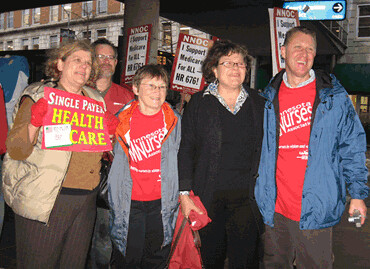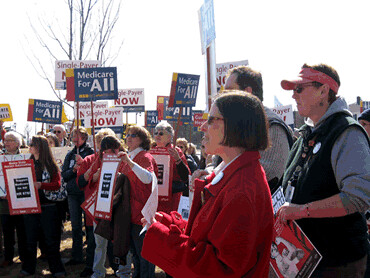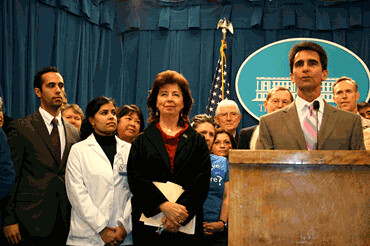With the final White House Forum on healthcare scheduled Monday, April 6 in downtown Los Angeles, advocates of single payer/guaranteed healthcare have one more opportunity to shake up what has become a dreary conventional wisdom about the presumed acceptable parameters of the debate.
Hundreds of nurses, doctors, healthcare and labor activists will rally at 9 a.m. outside the California Endowment, 1000 North Alameda St., Los Angeles.
It will mark the fifth time, at all five White House regional forums, that the single payer/Medicare for all message will come to the stage, outside and inside the forum. You can extend that to the town hall meeting at the White House last week where the President was asked why we can't have a national healthcare system like they have in other industrialized nations.
But the scene is very different in the committee rooms where the top legislators, with their handpicked insiders, either from the healthcare industry or conventional players who won't upset the status quo, have determined the general framework of a legislative approach they deem acceptable — and dismissed as out of bounds the one reform most likely to work, a single payer approach.
While single payer is not on the table, accommodating the insurance industry and healthcare proposals by the party that was trounced in the polls in November apparently is.
That's why two of the biggest debates now are not over whether to adopt a national healthcare system, that has guaranteed access to care in every other industrialized nation, but whether to force people to buy private insurance and to tax their employer-funded health benefits.
Start with requiring everyone not covered to buy insurance, which amounts to a massive bailout for the insurance industry. The Democratic chairs of the key committees that are running the show on healthcare have all agreed that individual mandate, putting us all in hock to the insurance giants, will be part of the bill, the New York Times' Robert Pear reported this morning.
Their alleged premise, says Pear, “that if everyone had health insurance, it would be easier to control health costs.”
Not to mention that it is the top priority for the insurance industry, which is salivating at the prospect of tens of millions of new customers marched into their offices under threat of federal penalties.
But it's not so popular with everyone else — a major reason why the individual mandate plan by Gov. Arnold Schwarzenegger, host of the LA forum, crashed and burned last year. And it hasn't worked so well in its prime model, Massachusetts, either.
Listen to the comments of Massachusetts State Sen. Jamie Eldridge, who voted for the law, but recently gave this assessment to a Congressional committee, as reported by healthcare writer extraordinaire, Trudy Lieberman at the Columbia Journalism Review:
The assumption was that, as more people—and, in particular, more young and relatively healthy people—joined the system, premiums would go down across the board. There was also the assumption that as more people became insured, the number of people going to the emergency room would drop dramatically, saving the Commonwealth money. Neither of those things have happened—at least not enough to produce the cost savings we were told we would see. In fact, health care reform has cost the Commonwealth much more than expected—-up to a record $1.3 billion this year. It is maddening that so many of our public health care dollars are diverted to HMOs and health insurance companies, under the current employer-based Massachusetts health care system.
As to taxing benefits, turn the page back to the fall campaign when that idea, the centerpiece of Sen. John McCain's healthcare plan, was widely denounced by soon-to-be President Obama and virtually every other Democrat running for office in stump speeches, election mail, and numerous TV ads.
It was considered so distasteful Sen. Joe Biden even found it to be a handy zinger to Gov. Palin in the vice-presidential debate, saying: “Taxing your healthcare benefit. I call that the ultimate Bridge to Nowhere.”
But, apparently that was then and this is now, as the Los Angeles Times affirmed this week:
Democrats and Republicans on Capitol Hill are expressing increasing openness to an idea that once seemed unthinkable: putting taxes on some healthcare benefits.
And Peter Orzag, the Obama administration's budget director, told the Washington Post that taxing benefits “should most definitely remain on the table.” Unlike real reform, apparently.
What changed? Lieberman has one idea:
What happened to Obama’s budget proposal of a $634 billion down payment (for health care reform) that was to be funded in part by making wealthier people pay higher income taxes? Or the $175 billion that was to be saved by cutting the excess payments to Medicare Advantage plans over ten years? … The Senate draft budget doesn’t contain any actual money for health care. Instead…there will be “space” for a health reform reserve fund. No taxing the rich—members of Congress beat up on that one. No trimming Medicare Advantage plans—insurers don’t like that.
The $634 billion figure was always too small to provide all the subsidies people will need if they are required to buy health insurance, which seems to be the direction the pols are going. But if Obama’s revenue source doesn’t survive the budget process, then where does the money come from? … Bingo! The money might just come from taxing the health insurance benefits of … everyone else who gets insurance from their boss.
Ironically, the main reason President Obama says single payer reform is not under consideration is because it would “scrap (the employer based system) everybody is accustomed to,” as he said in the town hall meeting last week in response to the question of why we can't have the system that works for everyone else:
But demolishing what we have now is almost exactly what would happen when you tax health care benefits.
Many if not most of the youngest and healthiest employees, especially in a recession, would drop their employer coverage to shop for cheaper, barebones plans in the private individual market.
Employers, left with the more expensive employees to cover and an unsustainable risk pool, would see their premium costs skyrocket even more, prompting many to sharply reduce coverage or eliminate benefits entirely.
As Texas employers and healthcare analysis succinctly told the Dallas Morning News' Jason Roberson during the campaign, “this could eventually lead to the death of company-provided health plans.”
Some seem to have forgotten that consequence. On April 6, come help us remind them.



